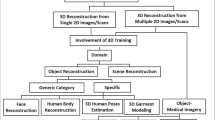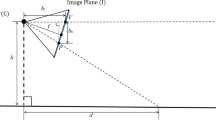Abstract
This paper describes the combination of several novel algorithms into a system that obtains visual motion from a sequence of images and uses it to recover a three-dimensional description of the motion and geometry of the scene in terms of moving extended straight edges. The system goes on to recognize the recovered geometry as an object from a database of wireframe models, a stage that also resolves the depth/speed scaling ambiguity inherent in visual motion processing, resulting in absolute depth and motion recovery. The processing sequence is demonstrated on imagery from a well-carpentered CSG model and on natural imagery of simple polyhedral objects.
Similar content being viewed by others
References
H. von Helmholtz, in Handbuch der physiologischen Optik. Voss, Leipzig, 1866: Ed. and trans. by J.P.C. Southall, Dover, New York, 1962.
H. Wallach and D.N. O'Connell, “The kinetic depth effect”, J. Exp. Psychol. 45:205–217, 1953.
G. Johansson, “Visual perception of biological motion and a model for its analysis”, Percep. Psychophy. 14:201–211, 1973.
D.R. Proffitt and B.I. Bertenthal, “Converging approaches to extracting structure from motion: psychophysical and computational investigations of recovering connectivity from moving point-light displays”. in Proc. 1st Conf. on Artif. Intell. Applications, Denver, December 1984, pp. 232–238 (IEEE Computer Society Press, Silver Spring, MD, 1984).
B.G. Schunck, “The image flow constraint equation”, Compu. Vis., Graph. Image Process. 35, pp. 20–46, 1986.
A. Verri and T. Poggio, “Against quantitative optical flow”, Proc. 1st Intern. Conf. Computer Vision, London, June 1987, pp. 171–180 (IEEE Computer Society Press, Washington, D.C.).
B.K.P. Horn and B.G. Schunck, “Determining optical flow”, Artificial Intelligence 17:185–203, 1981.
B.F. Buxton and H. Buxton, “Monocular depth perception from optical flow by space-time signal processing”, Proc. Roy. Soc. London B 218:22–47, 1983.
D.J. Heeger, “Optical flow from spatiotemporal filters”, Proc. 1st Intern. Conf. Computer Vision, London, 1987, pp. 181–190 (IEEE Computer Society Press, Washington, D.C., 1987).
R.Y. Tsai and T.S. Huang, “Estimating 3D motion parameters of a rigid planar patch”, Report R-921, Coord. Sci. Lab. University of Illinois, 1981.
H.C. Longuet-Higgins, “The visual ambiguity of a moving plane,” Proc. R.Y. Soc. London B 223:165–175, 1984.
B.F. Buxton, H. Buxton, D.W. Murray, and N.S. Williams, “3D solutions to the aperture problem,” Proc. 6th European Conf. on Artificial Intelligence, Pisa, 1984, ed. T. O'Shea, pp. 631–640 (Elsevier, Amsterdam, 1984).
R.Y. Tsai and T.S. Huang, “Uniqueness and estimation of threedimensional motion parameters of rigid objects with curved surfaces,” IEEE Trans. PAMI 6:13–27, 1984.
A.M. Waxman and K. Wohn, “Contour evolution, neighborhood deformation and global image flow: planar surfaces in motion,” Intern. J. Robotics Res. 4:95–108, 1985.
A.M. Waxman, B. Kamgar-Parsi, and M. Subbarao, “Closed-form solutions to image flow equations for 3D structure and motion,” Intern. J. Computer Vision 1:239–258, 1987.
H. Westphal and H-H. Nagel, “Towards the derivation of threedimensional descriptions of image sequences for nonconvex moving objects,” comput. Vision, Graphics Image Process. 34:302–320, 1986.
C.G. Harris, M.C. Ibison, E.P. Sparkes, and M. Stephens, “Structure and motion from optical flow,” Proc. Alvey Vision Conf. Bristol UK, September 1986. To be published in Image and Vision Computing.
G.L. Scott, “Four-line method of locally estimating optic flow,” Image and Vision Computing 5:67–72, 1987.
W.E.L. Grimson and T. Lozano-Perez, “Model-based recognition and localization from sparse range or tactile data,” Intern. J. Robotics Res. 3:3–35, 1984.
W.E.L. Grimson and T. Lozano-Pérez, “Search and sensing strategies for recognition and localization of two and three dimensional objects,” Proc. 3rd Intern. Symp. Robotics Res. Gouvieux, France, October 1985, pp. 81–88, 1985.
D.W. Murray and D.B. Cook, “Using the orientation of fragmentary 3d edge segments for polyhedral object recognition,” Intern. J. Comput. Vision 2:147–163, 1988.
D.A. Castelow and D.W. Murray, “Computing visual motion by matching edges,” Preprint, 1988.
S. Ullman, The Interpretation of Visual Motion, MIT Press, Cambridge, MA 1979.
S. Ullman and E.C. Hildreth, “The measurement of visual motion,” in Physical and Biological Processing of Images, ed. O.J. Braddick and A.C. Sleigh, Springer-Verlag, Berlin, 1983.
D.H. Ballard and C.M. Brown, in Computer Vision, Prentice-Hall, NJ, 1982.
J.F. Canny, “Finding edges and lines in images,” AI-TR No. 720, Artificial Intelligence Laboratory, MIT, Cambridge, MA, 1983.
A. Rosenfeld and A.C. Kak, in Digital Picture Processing, vol. 2, Academic Press, New York, 1982.
P. Burt and B. Julesz, “Modifications of the classical notion of Panum's fusion area,” Perception 9:671–682, 1980.
S.B. Pollard, J.E.W. Mayhew, and J.P. Frisby, “PMF: a stereo correspondence algorithm using a disparity gradient limit,” Perception 14: 449–470, 1985.
S.A. Lloyd, “A binocular stero algorithm based on the disparity-gradient limit and using optimization theory,” Image and Vision Computing 3:177–181, 1985.
C.L. Fennema and W.B. Thompson, “Velocity determination in scenes containing several moving objects,” Comput. Graphics Image Process. 9:301–315, 1979.
B. Neumann. “Motion analysis of image sequences for object grouping and reconstruction,” Proc. Pattern Recog. Conf., Miami, FL, 1980.
A. Spoerri and S. Ullman, “The early detection of motion boundaries,” Proc. 1st Intern. Conf. Computer Vision, London, June 1987, pp. 209–218 (IEEE Computer Society Press, Washington, D.C., 1987).
W.B. Thompson and T-C. Pong, “Detecting moving objects,” Proc. 1st Intern. Conf. Computer Vision, London, June 1987, pp. 201–208 (IEEE Computer Society Press, Washington, D.C., 1987).
G. Adiv, “Determining 3-D motion and structure from optical flow generated by several moving objects,” IEEE Trans. PAMI 7:384–401, 1985.
D.W. Murray and B.F. Buxton, “Scene segmentation from visual motion using global optimization,” IEEE Trans. PAMI 9:220–228, 1987.
R.M. Haralick, “Computer vision theory: the lack thereof,” Comput. Vision, Graphics and Image Process. 36: 372–386, 1986.
J.B. Burns, A.R. Hanson, and E.M. Riseman, “Extracting straight lines,” IEEE Trans. PAMI 8:425–455, 1986.
A. Blake, A. Zisserman, and A.V. Papoulias, “Weak continuity constraints generate uniform scale-space descriptions of plane curves,” Proc. 7th European Conf. on Artificial Intelligence, July 1986, Brighton, UK, pp. 518–528.
U. Ramer, “Extraction of lines structures from photographs of curved objects,” Comput. Graphics and Image Process. 4:81–103, 1975.
H. Asada and J.M. Brady, “The curvature primal sketch,” Proc. Workshop on Computer Vision: Representation and Control, Annapolis, MD, (April 1984), pp. 8–17 (IEEE Computer Society Press, Silver Spring, MD, 1984).
Y. Yasumoto and G. Medioni, “Experiments in estimation of 3-d motion parameters from a sequence of image frames,” Proc. IEEE Conf. on Comput. Vision and Pattern Recog., San Francisco, pp. 89–94, 1985.
D.W. Marquardt, “An algorithm for the least-squares estimation of non-linear parameters,” J. Soc. Ind. Appl. Math. 11 (2): 431–441, 1963.
S.B. Pollard, J. Porrill, J.E.W. Mayhew, and J.P. Frisby, “Matching geometrical descriptions in three-space,” Image and Vision Computing 5:73–78, 1987.
R.C. Bolles, R. Horaud, and M.J. Hannah, “3-DPO: a three dimensional part orientation system,” Proc. 8th Intern. Joint Conf. Artificial Intelligence, Karlsruhe, FRG, pp. 1116–1120, 1983.
O.D. Faugeras and M. Hébert, “A 3D recognition and positioning algorithm using geometric matching between primitive surfaces,” Proc. Intern. Joint Conf. on Artificial Intelligence, Karlsruhe, pp. 996–1002, 1983.
B.D.P. Ruff, “Hardware implementation of the Canny edge detector,” in Workshop on Parallelism and Computer Vision, Oxford, March 1987. To be published (Oxford University Press).
J.M. Brady, “Seeds of perception,” Proc. 3rd Alvey Vision Conference, Cambridge, UK, September 1987, pp. 259–265.
Author information
Authors and Affiliations
Rights and permissions
About this article
Cite this article
Murray, D.W., Castelow, D.A. & Buxton, B.F. From image sequences to recognized moving polyhedral objects. Int J Comput Vision 3, 181–208 (1989). https://doi.org/10.1007/BF00133031
Issue Date:
DOI: https://doi.org/10.1007/BF00133031




